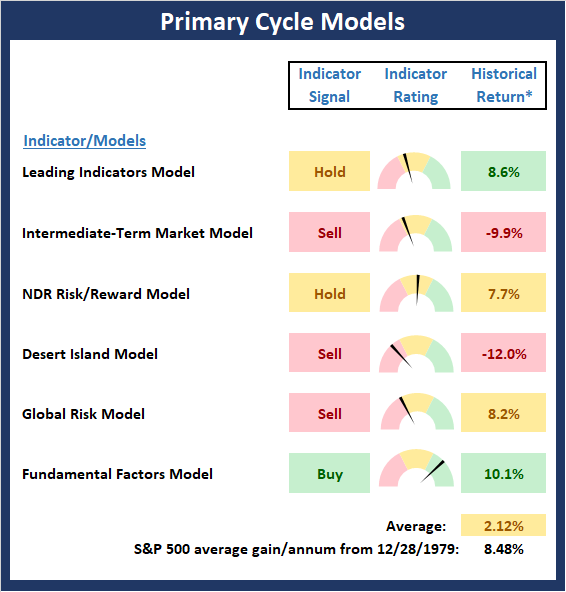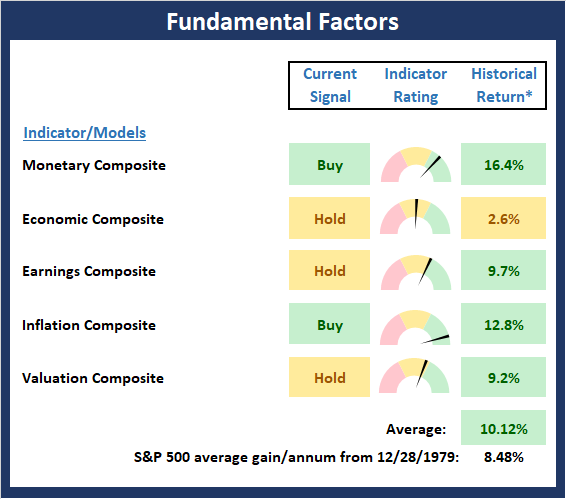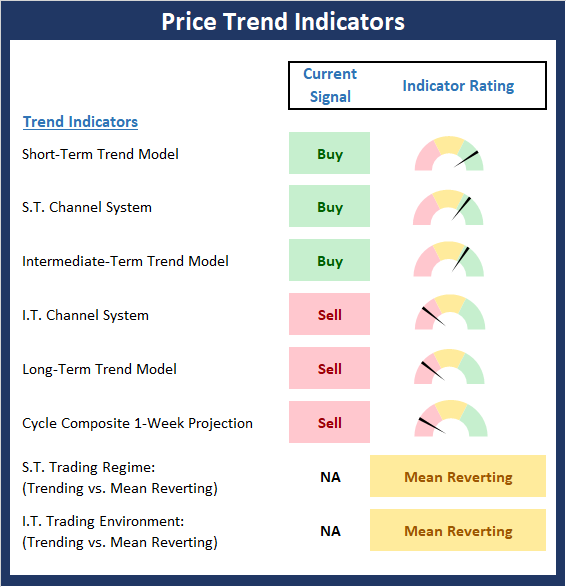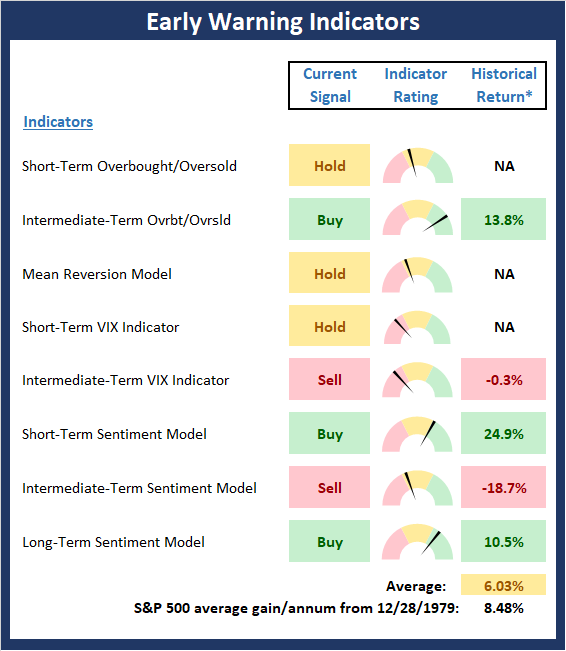Market Logic Can Be Confusing

Investors received a steady flow of really rotten news on many fronts last week. China's economy shrank by -6.8%. JPMorgan (JPM) CEO Jamie Dimon said we need to expect a "severe recession" as well as "meaningfully bad" credit card defaults. The IMF changed its 2020 global growth forecast to -3.0% from +3.3%. Goldman Sachs (GS) said the economic downturn will be four times worse than 2008. Super.
The hard data was also downright discouraging. We learned that Retail Sales fell a record -8.7% in March. Industrial Production plunged by -5.4% last month, which was the worst decline since 1946. Housing starts plummeted -22.3% in March. The Philly Fed Business Activity Index cratered 43.9 points in April to a reading of -56.6, a record low. The Conference Board's Leading Economic Index dropped by a record-breaking -6.7%. And the initial claims for unemployment insurance numbers were once again mind numbing, coming in at 5.25 million.
Speaking of unemployment, the number of continuing claims, which lag initial claims by one week, hit a record high of 11.98 million and are likely to rise again in next week's report. According to First Trust, the share of workers covered by unemployment insurance in the last three weeks has increased to 8.2% from record low of 1.2%. To put that in perspective, First Trust's Chief Economist Brian Wesbury tells us that the highest level in the past 50 years was 7.0% (seen in 1975). Oh, and these numbers are going to get worse. Joy.
So, how did the markets respond to all of the miserable data? Not surprisingly, the yield on the U.S. 10-Year Treasury Note fell from 0.729% to 0.654%, which, while still above the 0.5% seen on on 3/9, is in the vicinity of all-time lows. I think the key here is that while bond yields didn't crash on the week's bad news, they did move back toward the recent lows. So, the message from the bond market would appear to be that while the bad news was to be expected, it was still bad news.
On the other hand, the stock market had a completely different take. The S&P 500 rose 3.04% on the week, which finished off an impressive surge of 15.5% in just two weeks. And since the low seen on 3/23, the blue-chip index now sports a gain of 28.48%. Nice.
I know what you are thinking, the news is awful so naturally stocks surge. Got it. Wait, what?
Two Themes
One of the best books I read about the stock market at a young age was Stock Market Logic, by Norman Fosback. The key takeaway was to understand that the stock market has its own brand of logic, which is oftentimes both perverse and the exact opposite of what one might expect.
As I've said a time or twenty over the years, the key to understanding Ms. Market's game is to recognize the market is a discounting mechanism of future expectations. And while it may seem like a bit of a stretch, the stock market is currently looking ahead, well ahead... to better days.
This is one of the two key themes in the market right now. The first is, this too shall pass, and that we can count on science to allow us to return to some form of normal at some point in the future. The second is an oldie but a goody, the Fed has once again mounted their white horses.
The Fed Changed The Rules Of The Game
As the COVID-19 crisis began, one of the primary fears was that the Fed couldn't fix the virus problem. Slashing interest rates to zero and buying bonds just wasn't going to do the trick. The thinking was that while the Fed and fiscal stimulus could make things less bad, they couldn't have a significant impact on the problem.
But that was then. That was before the dynamic duo of Steven Mnuchin and Jay Powell (who apparently are best buds) got together and decided to change the game. And while these guys can't fix the virus, they do appear to have (a) taken the worst case scenario off the table (i.e. another credit crisis) and (b) are putting some sort of a floor under the economy.
To be sure, we are looking at a nasty recession. But the thing to remember is that this recession is self-induced. Things were just fine, thank you, before the virus hit. And since the Fed/Government had a playbook of their own to follow and decided to move fast and hard against this crisis, the damage is likely to be lessened significantly.
The key here is the Fed changed the rules of the game. You see, by law the Fed isn't allowed to buy stuff like corporate bond ETFs, municipal bonds, etc. And they are definitely not allowed to talk about buying the S&P 500 ETF (SPY).
But via the new partnership between the Fed, Treasury, and a little firm called BlackRock (BLK), almost anything is possible now. And this is a game changer for the markets.
Using a sports analogy, the Fed didn't just move the goal posts here. No, they made the goal posts the entire width of the field!
How It Works
So, here's what is happening. Fed and Treasury get together to create something called an SPV (Special Purpose Vehicle). The Treasury then sells a bunch of bonds, which the Fed buys. The proceeds of the bond sales are then placed into the SPV. Note that the SPV can then "lever up" the money it has in its account and spend something like 10 times the amount of money available - on basically anything it wants. There are none of those annoying restrictions the Fed has to deal with placed on the SPV (and yes, I'm being sarcastic here).
Bam! Just like that, the Fed effectively CAN buy corporate bonds, junk bonds, muni bonds, ETFs of all shapes and sizes, and even stocks in order to support markets and send a warning to those nasty short sellers.
The other thing to know here is that the Fed doesn't act like a prudent money manager and move into positions slowly. No, when the Fed decides to buy, they do so with a BIG splash. They don't care what price they get. No, instead they want to send a message to the market that "enough is enough" and further short-selling may cause significant pain. Remember, the buyer of last resort has an almost limitless checkbook. And Jay Powell has said the Fed will "do anything it takes" to support the economy during this crisis. Talk about a bazooka!
Next, understand if traders have learned anything since the 2008 crisis, it is to "shake hands with the government" when they are buying stuff. In other words, traders know that one of the oldest rules in the game is "don't fight the Fed." And since the Fed usually gets what it wants in the end, if the Fed is talking about buying, traders want to be in a front-running position.
From my seat, this is at least part of the reason why stocks are ignoring all the bad news and movin' on up. The other is the "looking ahead" thing.
Theme #2: Looking Ahead
The second theme that appears to be giving the market a lift is there was actually some good news on the virus front last week. As such, the idea is that we should just "write off" 2020 (we already know it will be ugly) and "look ahead" to the "grand re-opening" of the economy.
Sprinkled in between all the grotesque economic news was some good news regarding COVID-19. We heard that the "curve" appears to be peaking in NYC. We heard that GlaxoSmithKline (GSK) is teaming up Sanofi (SNY) on a vaccine and could produce hundreds of millions of doses by the end of 2021. We heard that Johnson & Johnson (JNJ) could produce 900 million vaccine doses by April 2021 (assuming the vaccine works in the trial slated to begin in the fall, of course!). And we heard that Gilead's (GILD) drug, Remdesivir is showing promising results in something called a "compassionate trial" with 120 patients in Chicago.
The key to the Remdesivir news is that IF (note the use of capital letters) the results continue to be good in expanded trials (something that Gilead itself has warned against becoming overly optimistic about), then something akin to a "cure" might be available until a vaccine can make its way to the masses.
In other words, IF (again, all caps) we can find a "drug therapy" that keeps people out of the hospital and/or off of ventilators, then we actually COULD start talking about the economy going back to some semblance of "normal."
The War Playbook
I've written that perhaps the best analog to follow for this market is the "war playbook." Prior to war breaking out, the market tends to freak out about what could happen to the economy. However, once the war begins, it is the news of "how the war is going" that drives the markets.
This concept helps support the idea that stocks can ignore all the bad economic news and look ahead. IF there is promising news on the war front (Remdesivir and others as well as the development of a vaccine in record time) then stocks may be able to continue to advance for a while as the market "discounts" future expectations.
But if the news from the virus front starts to turn bad, well, we all know what will happen next.
Pulling Good News Forward
In closing, it is important to remember that stocks can only "discount" a concept such as winning the war on COVID-19 sometime in the next 3-6 months, for so long. I.E. Stocks can only go so far without actual good news on the virus and the economy.
Remember, unless a "cure" is found in the next few weeks, economic damage will continue to be done - damage that is unlikely to be reversed quickly. In addition, consumer behavior is rapidly changing. And the longer consumers are removed from their "old normal," the more likely it is that the new behavior such as spending less, doing less, saving money, paying down debt, etc. will become "the new normal."
And IF "the new normal" takes root with consumers, then economic growth could be hard to find. Which, in turn, means earnings growth might be difficult to achieve. As such, an environment with "slow" or "no" growth is a distinct possibility - which isn't exactly a great backdrop for rising stock prices.
The bottom line is that while stocks are indeed looking ahead to better days here, the ultimate upside is limited in the near-term. And I, for one, think that a battle between expectations versus reality will likely result.
Weekly Market Model Review
Each week we do a disciplined, deep dive into our key market indicators and models. The overall goal of this exercise is to (a) remove emotion from the investment process, (b) stay "in tune" with the primary market cycles, and (c) remain cognizant of the risk/reward environment.
The Major Market Models
We start with six of our favorite long-term market models. These models are designed to help determine the "state" of the overall market.
There is one change to report on the Primary Cycle board this week. My "Desert Island Model" flip-flopped again, this time moving from neutral to negative. Overall, the board is currently rated as moderately negative. This tells me that while the bulls have enjoyed a whale of a rally, some caution remains warranted.

* Source: Ned Davis Research (NDR) as of the date of publication. Historical returns are hypothetical average annual performances calculated by NDR. Past performances do not guarantee future results or profitability - NOT INDIVIDUAL INVESTMENT ADVICE.
View My Favorite Market Models Online
The State of the Fundamental Backdrop
Next, we review the market's fundamental factors in the areas of interest rates, the economy, inflation, and valuations.
I recently pointed out the improvement in valuations, which, from my point of view, helped justify the idea that a preliminary (and perhaps final) low had been established. The bad news is that the ferocious bounce seen over the last three weeks has pushed valuations back into the neutral zone. My thinking is this represents a fundamental problem with the bull theme that stocks can simply fast forward to when the economy recovers.

* Source: Ned Davis Research (NDR) as of the date of publication. Historical returns are hypothetical average annual performances calculated by NDR. Past performances do not guarantee future results or profitability - NOT INDIVIDUAL INVESTMENT ADVICE.
View Fundamental Indicator Board Online
The State of the Trend
After looking at the big-picture models and the fundamental backdrop, I like to look at the state of the trend. This board of indicators is designed to tell us about the overall technical health of the current trend.
Not surprisingly, the Trend board remains in pretty good shape. However, it is important to keep in mind that there has been significant technical damage done to the tape as evidenced by the I.T. Channel and Long-Term Trend model readings. My take is the rally will likely encounter some resistance in the coming days.

NOT INDIVIDUAL INVESTMENT ADVICE.
View Trend Indicator Board Online
The State of Internal Momentum
Next, we analyze the "oomph" behind the current trend via our group of market momentum indicators/models.
The Momentum Board saw some improvement this week as our thrust indicators all now sport a bright shade of green and our trend/breadth confirm model has been upgraded to neutral. But since this board weights the intermediate- and long-term more than the short-term, the overall rating of the board is neutral.

* Source: Ned Davis Research (NDR) as of the date of publication. Historical returns are hypothetical average annual performances calculated by NDR. Past performances do not guarantee future results or profitability - NOT INDIVIDUAL INVESTMENT ADVICE.
View Momentum Indicator Board Online
Early Warning Signals
Once we have identified the current environment, the state of the trend, and the degree of momentum behind the move, we then review the potential for a counter-trend move to begin. This batch of indicators is designed to suggest when the table is set for the trend to "go the other way."
The Early Warning board is a bit of a mess at this point. From a short-term perspective, stocks are now overbought. But from an intermediate-term point of view, they remain oversold. In addition, the VIX indicators are suggesting that the table is beginning to be set up for a countertrend move. Historically, the best countertrend moves occur when "the stars are aligned" in terms of overbought/sold, volatility, and sentiment indicators. And this is simply not the case here.

* Source: Ned Davis Research (NDR) as of the date of publication. Historical returns are hypothetical average annual performances calculated by NDR. Past performances do not guarantee future results or profitability - NOT INDIVIDUAL INVESTMENT ADVICE.
View Early Warning Indicator Board Online
Thought For The Day:
It's what you learn after you know it all that counts. -Earl Weaver
Wishing you green screens and all the best for a great day,

David D. Moenning
Founder, Chief Investment Officer
Heritage Capital Research
Disclosures
At the time of publication, Mr. Moenning held long positions in the following securities mentioned: GS, BLK, JNJ, SPY - Note that positions may change at any time.
Leading Indicators Model: A group of indicators that have historically shown tendencies to lead the market at major turning points.
Intermediate-Term Market Model: A composite model (model of models) focused on trend and momentum indicators which has been designed to provide identify intermediate-term trading opportunities.
Risk/Reward Model: A model-of-models intended to provide an overall view of the state of the risk/reward environment. The model includes tape, monetary, and sentiment indicators as well as 7 big-picture market model readings.
Desert Island Model: If I was stranded on a desert island with access to only one market model to manage money with, this would be the model. The model is a comprehensive model-of-models comprised of trend, momentum, mean reversion, economic, monetary, sentiment, and factor-based indicators/models.
External Factors Model: A model-of-models designed to provide a reading on the "macro state" of the market environment. The model is comprised of indicators/models in the areas of various index yields, industrial production, investors sentiment, and historic volatility.
Short-Term Trend-and-Breadth Signal Explained: History shows the most reliable market moves tend to occur when the breadth indices are in gear with the major market averages. When the breadth measures diverge, investors should take note that a trend reversal may be at hand. This indicator incorporates NDR's All-Cap Dollar Weighted Equity Series and A/D Line. From 1998, when the A/D line is above its 5-day smoothing and the All-Cap Equal Weighted Equity Series is above its 25-day smoothing, the equity index has gained at a rate of +32.5% per year. When one of the indicators is above its smoothing, the equity index has gained at a rate of +13.3% per year. And when both are below, the equity index has lost +23.6% per year.
Channel Breakout System Explained: The short-term and intermediate-term Channel Breakout Systems are modified versions of the Donchian Channel indicator. According to Wikipedia, "The Donchian channel is an indicator used in market trading developed by Richard Donchian. It is formed by taking the highest high and the lowest low of the last n periods. The area between the high and the low is the channel for the period chosen."
Intermediate-Term Trend-and-Breadth Signal Explained: This indicator incorporates NDR's All-Cap Dollar Weighted Equity Series and A/D Line. From 1998, when the A/D line is above its 45-day smoothing and the All-Cap Equal Weighted Equity Series is above its 45-day smoothing, the equity index has gained at a rate of +17.6% per year. When one of the indicators is above its smoothing, the equity index has gained at a rate of +6.5% per year. And when both are below, the equity index has lost -1.3% per year.
Cycle Composite Projections: The cycle composite combines the 1-year Seasonal, 4-year Presidential, and 10-year Decennial cycles. The indicator reading shown uses the cycle projection for the upcoming week.
Trading Mode Indicator: This indicator attempts to identify whether the current trading environment is "trending" or "mean reverting." The indicator takes the composite reading of the Efficiency Ratio, the Average Correlation Coefficient, and Trend Strength models.
Volume Relationship Models: These models review the relationship between "supply" and "demand" volume over the short- and intermediate-term time frames.
Price Thrust Model Explained: This indicator measures the 3-day rate of change of the Value Line Composite relative to the standard deviation of the 30-day average. When the Value Line's 3-day rate of change have moved above 0.5 standard deviation of the 30-day average ROC, a "thrust" occurs and since 2000, the Value Line Composite has gained ground at a rate of +20.6% per year. When the indicator is below 0.5 standard deviation of the 30-day, the Value Line has lost ground at a rate of -10.0% per year. And when neutral, the Value Line has gained at a rate of +5.9% per year.
Volume Thrust Model Explained: This indicator uses NASDAQ volume data to indicate bullish and bearish conditions for the NASDAQ Composite Index. The indicator plots the ratio of the 10-day total of NASDAQ daily advancing volume (i.e., the total volume traded in stocks which rose in price each day) to the 10-day total of daily declining volume (volume traded in stocks which fell each day). This ratio indicates when advancing stocks are attracting the majority of the volume (readings above 1.0) and when declining stocks are seeing the heaviest trading (readings below 1.0). This indicator thus supports the case that a rising market supported by heavier volume in the advancing issues tends to be the most bullish condition, while a declining market with downside volume dominating confirms bearish conditions. When in a positive mode, the NASDAQ Composite has gained at a rate of +38.3% per year, When neutral, the NASDAQ has gained at a rate of +13.3% per year. And when negative, the NASDAQ has lost at a rate of -14.279% per year.
Breadth Thrust Model Explained: This indicator uses the number of NASDAQ-listed stocks advancing and declining to indicate bullish or bearish breadth conditions for the NASDAQ Composite. The indicator plots the ratio of the 10-day total of the number of stocks rising on the NASDAQ each day to the 10-day total of the number of stocks declining each day. Using 10-day totals smooths the random daily fluctuations and gives indications on an intermediate-term basis. As expected, the NASDAQ Composite performs much better when the 10-day A/D ratio is high (strong breadth) and worse when the indicator is in its lower mode (weak breadth). The most bullish conditions for the NASDAQ when the 10-day A/D indicator is not only high, but has recently posted an extreme high reading and thus indicated a thrust of upside momentum. Bearish conditions are confirmed when the indicator is low and has recently signaled a downside breadth thrust. In positive mode, the NASDAQ has gained at a rate of +22.1% per year since 1981. In a neutral mode, the NASDAQ has gained at a rate of +14.5% per year. And when in a negative mode, the NASDAQ has lost at a rate of -6.4% per year.
Short-Term Overbought/sold Indicator: This indicator is the current reading of the 14,1,3 stochastic oscillator. When the oscillator is above 80 and the %K is above the %D, the indicator gives an overbought reading. Conversely, when the oscillator is below 20 and %K is below its %D, the indicator is oversold.
Intermediate-Term Overbought/sold Indicator: This indicator is a 40-day RSI reading. When above 57.5, the indicator is considered overbought and wnen below 45 it is oversold.
Mean Reversion Model: This is a diffusion model consisting of five indicators that can produce buy and sell signals based on overbought/sold conditions.
VIX Indicator: This indicators looks at the current reading of the VIX relative to standard deviation bands. When the indicator reaches an extreme reading in either direction, it is an indication that a market trend could reverse in the near-term.
Short-Term Sentiment Indicator: This is a model-of-models composed of 18 independent sentiment indicators designed to indicate when market sentiment has reached an extreme from a short-term perspective. Historical analysis indicates that the stock market's best gains come after an environment has become extremely negative from a sentiment standpoint. Conversely, when sentiment becomes extremely positive, market returns have been subpar.
Intermediate-Term Sentiment Indicator: This is a model-of-models composed of 7 independent sentiment indicators designed to indicate when market sentiment has reached an extreme from a intermediate-term perspective. Historical analysis indicates that the stock market's best gains come after an environment has become extremely negative from a sentiment standpoint. Conversely, when sentiment becomes extremely positive, market returns have been subpar.
Long-Term Sentiment Indicator: This is a model-of-models composed of 6 independent sentiment indicators designed to indicate when market sentiment has reached an extreme from a long-term perspective. Historical analysis indicates that the stock market's best gains come after an environment has become extremely negative from a sentiment standpoint. Conversely, when sentiment becomes extremely positive, market returns have been subpar.
Absolute Monetary Model Explained: The popular cliche, "Don't fight the Fed" is really a testament to the profound impact that interest rates and Fed policy have on the market. It is a proven fact that monetary conditions are one of the most powerful influences on the direction of stock prices. The Absolute Monetary Model looks at the current level of interest rates relative to historical levels and Fed policy.
Relative Monetary Model Explained: The "relative" monetary model looks at monetary indicators relative to recent levels as well as rates of change and Fed Policy.
Economic Model Explained: During the middle of bull and bear markets, understanding the overall health of the economy and how it impacts the stock market is one of the few truly logical aspects of the stock market. When our Economic model sports a "positive" reading, history (beginning in 1965) shows that stocks enjoy returns in excess of 21% per year. Yet, when the model's reading falls into the "negative" zone, the S&P has lost nearly -25% per year. However, it is vital to understand that there are times when good economic news is actually bad for stocks and vice versa. Thus, the Economic model can help investors stay in tune with where we are in the overall economic cycle.
Inflation Model Explained: They say that "the tape tells all." However, one of the best "big picture" indicators of what the market is expected to do next is inflation. Simply put, since 1962, when the model indicates that inflationary pressures are strong, stocks have lost ground. Yet, when inflationary pressures are low, the S&P 500 has gained ground at a rate in excess of 13%. The bottom line is inflation is one of the primary drivers of stock market returns.
Valuation Model Explained: If you want to get analysts really riled up, you need only to begin a discussion of market valuation. While the question of whether stocks are overvalued or undervalued appears to be a simple one, the subject is actually extremely complex. To simplify the subject dramatically, investors must first determine if they should focus on relative valuation (which include the current level of interest rates) or absolute valuation measures (the more traditional readings of Price/Earnings, Price/Dividend, and Price/Book Value). We believe that it is important to recognize that environments change. And as such, the market's focus and corresponding view of valuations are likely to change as well. Thus, we depend on our Valuation Models to help us keep our eye on the ball.
Disclosures
NOT INVESTMENT ADVICE. The opinions and forecasts expressed herein are those of Mr. David Moenning and Heritage Capital Research and may not actually come to pass. The opinions and viewpoints regarding the future of the markets should not be construed as recommendations. The analysis and information in this report is for informational purposes only. No part of the material presented in this report is intended as an investment recommendation or investment advice. Neither the information nor any opinion expressed constitutes a solicitation to purchase or sell securities or any investment program.
Any investment decisions must in all cases be made by the reader or by his or her investment adviser. Do NOT ever purchase any security without doing sufficient research. There is no guarantee that the investment objectives outlined will actually come to pass. All opinions expressed herein are subject to change without notice. Neither the editor, employees, nor any of their affiliates shall have any liability for any loss sustained by anyone who has relied on the information provided.
Mr. Moenning of Heritage Capital Research is an investment adviser representative of Eastsound Capital Advisors, LLC, a registered investment advisor. The adviser may not transact business in states where it is not appropriately registered, excluded or exempted from registration. Individualized responses to persons that involve either the effecting of transaction in securities, or the rendering of personalized investment advice for compensation, will not be made without registration or exemption.
Mr. Moenning and Heritage Capital Research may at times have positions in the securities referred to and may make purchases or sales of these securities while publications are in circulation. Positions may change at any time.
The analysis provided is based on both technical and fundamental research and is provided "as is" without warranty of any kind, either expressed or implied. Although the information contained is derived from sources which are believed to be reliable, they cannot be guaranteed.
The author neither endorses nor warrants the content of this site, any embedded advertisement, or any linked resource. The author or his managed funds may hold either long or short positions in the referenced securities. Republication rights must be expressly granted by author in writing.
Investments in equities carry an inherent element of risk including the potential for significant loss of principal. Past performance is not an indication of future results.

